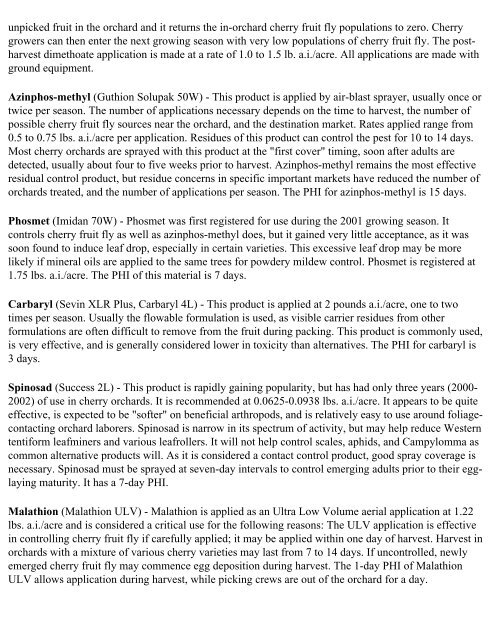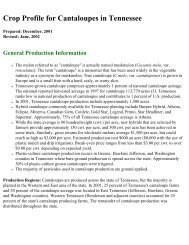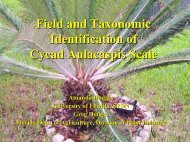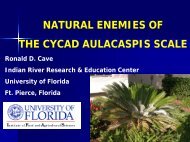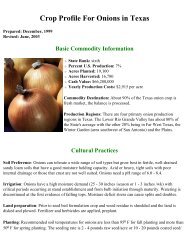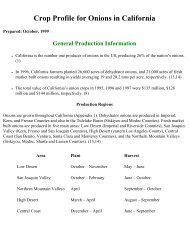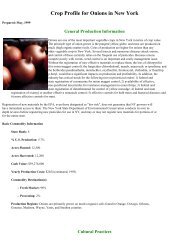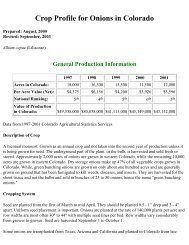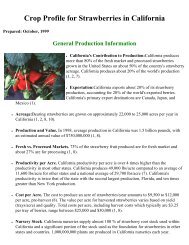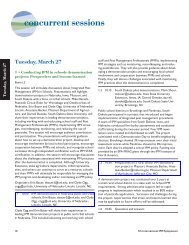Crop Profile for Cherries (Sweet) - Regional IPM Centers
Crop Profile for Cherries (Sweet) - Regional IPM Centers
Crop Profile for Cherries (Sweet) - Regional IPM Centers
Create successful ePaper yourself
Turn your PDF publications into a flip-book with our unique Google optimized e-Paper software.
unpicked fruit in the orchard and it returns the in-orchard cherry fruit fly populations to zero. Cherry<br />
growers can then enter the next growing season with very low populations of cherry fruit fly. The postharvest<br />
dimethoate application is made at a rate of 1.0 to 1.5 lb. a.i./acre. All applications are made with<br />
ground equipment.<br />
Azinphos-methyl (Guthion Solupak 50W) - This product is applied by air-blast sprayer, usually once or<br />
twice per season. The number of applications necessary depends on the time to harvest, the number of<br />
possible cherry fruit fly sources near the orchard, and the destination market. Rates applied range from<br />
0.5 to 0.75 lbs. a.i./acre per application. Residues of this product can control the pest <strong>for</strong> 10 to 14 days.<br />
Most cherry orchards are sprayed with this product at the "first cover" timing, soon after adults are<br />
detected, usually about four to five weeks prior to harvest. Azinphos-methyl remains the most effective<br />
residual control product, but residue concerns in specific important markets have reduced the number of<br />
orchards treated, and the number of applications per season. The PHI <strong>for</strong> azinphos-methyl is 15 days.<br />
Phosmet (Imidan 70W) - Phosmet was first registered <strong>for</strong> use during the 2001 growing season. It<br />
controls cherry fruit fly as well as azinphos-methyl does, but it gained very little acceptance, as it was<br />
soon found to induce leaf drop, especially in certain varieties. This excessive leaf drop may be more<br />
likely if mineral oils are applied to the same trees <strong>for</strong> powdery mildew control. Phosmet is registered at<br />
1.75 lbs. a.i./acre. The PHI of this material is 7 days.<br />
Carbaryl (Sevin XLR Plus, Carbaryl 4L) - This product is applied at 2 pounds a.i./acre, one to two<br />
times per season. Usually the flowable <strong>for</strong>mulation is used, as visible carrier residues from other<br />
<strong>for</strong>mulations are often difficult to remove from the fruit during packing. This product is commonly used,<br />
is very effective, and is generally considered lower in toxicity than alternatives. The PHI <strong>for</strong> carbaryl is<br />
3 days.<br />
Spinosad (Success 2L) - This product is rapidly gaining popularity, but has had only three years (2000-<br />
2002) of use in cherry orchards. It is recommended at 0.0625-0.0938 lbs. a.i./acre. It appears to be quite<br />
effective, is expected to be "softer" on beneficial arthropods, and is relatively easy to use around foliagecontacting<br />
orchard laborers. Spinosad is narrow in its spectrum of activity, but may help reduce Western<br />
tenti<strong>for</strong>m leafminers and various leafrollers. It will not help control scales, aphids, and Campylomma as<br />
common alternative products will. As it is considered a contact control product, good spray coverage is<br />
necessary. Spinosad must be sprayed at seven-day intervals to control emerging adults prior to their egglaying<br />
maturity. It has a 7-day PHI.<br />
Malathion (Malathion ULV) - Malathion is applied as an Ultra Low Volume aerial application at 1.22<br />
lbs. a.i./acre and is considered a critical use <strong>for</strong> the following reasons: The ULV application is effective<br />
in controlling cherry fruit fly if carefully applied; it may be applied within one day of harvest. Harvest in<br />
orchards with a mixture of various cherry varieties may last from 7 to 14 days. If uncontrolled, newly<br />
emerged cherry fruit fly may commence egg deposition during harvest. The 1-day PHI of Malathion<br />
ULV allows application during harvest, while picking crews are out of the orchard <strong>for</strong> a day.


